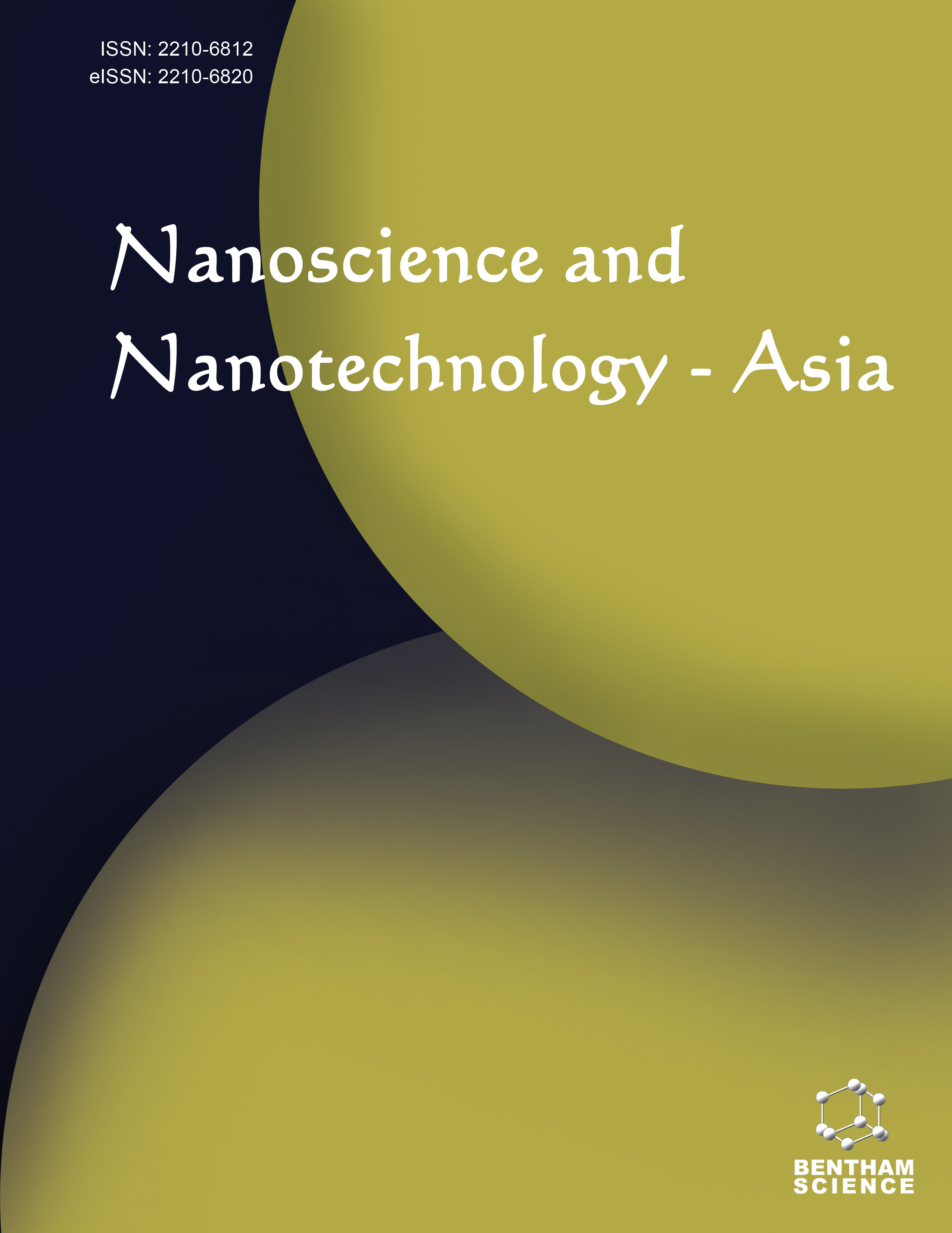- Home
- A-Z Publications
- Nanoscience & Nanotechnology-Asia
- Previous Issues
- Volume 10, Issue 1, 2020
Nanoscience & Nanotechnology-Asia - Volume 10, Issue 1, 2020
Volume 10, Issue 1, 2020
-
-
Approaches to Graphene, Carbon Nanotube and Carbon nanohorn, Synthesis, Properties and Applications
More LessBy Ali HasaniBy far the most important members of carbon-based materials family, are graphene, Carbon Nanotube (CNT) and Carbon Nanohorn (CNH). Thanks to their outstanding features and effective applications, have been broadly researched in recent times. Numerous ways have been proposed to synthesize graphene, CNT and CNH. This paper presents an overview of approaches to graphene, CNT and CNH synthesis, properties an Read More
-
-
-
Ultra-deformable Liposomes as Flexible Nanovesicular Carrier to Penetrate Versatile Drugs Transdermally
More LessAuthors: Gaurav Tiwari, Ruchi Tiwari, Rachna Singh and Awani K. RaiIntroduction: Transferosomes also known as ultra-deformable liposomes were introduced by Gregor Cevc in 1990. These are deformable vesicles that transport drug across the skin, which is the best route of drug delivery because skin is the largest human organ with 3 kg total weight and a surface area of 1.5-2.0 m2. Methods: Transferosomes are able to efficiently deliver low as well as high molecular weight drug across the Read More
-
-
-
Al-Au Heterogeneous Dimer-trimer Nanostructure for SERS
More LessBy Jyoti KatyalBackground: Tunability in resonance wavelength and the enhancement of the electromagnetic field intensities around the surface are two unique properties which make metal as a plasmonic material. A theoretical investigation on the LSPR and field enhancement for heterogeneous dimer–trimer metallic nanostructure by constituting Al and Au as two different plamsonic materials has been studied. Since electrons in Al exhi Read More
-
-
-
CdSe Quantum Dots to Quantum Rods: Transition Studies and Evaluation of Sensitivity as Transducers for Biosensing Glucose
More LessAuthors: Amit D. Saran and Jayesh R. BellareBackground: The estimation of glucose level in the blood serum, has been widely used as a clinical indicator of diabetes. Optical and electrochemical sensing of glucose widely uses Glucose Oxidase (GOD) enzyme, as the catalyst for glucose oxidation, which releases hydrogen peroxide (H2O2). Optical biosensors are superior to their electrochemical counter-parts as they are resistant to electromagnetic interfer Read More
-
-
-
Role of Green Silver Nanoparticles in the Inhibition of Listeria monocytogenesand Escherichia coli
More LessAuthors: Anvesha Sinha and Jayanand ManjhiBackground: The quandary of antimicrobial resistance is rapidly becoming a cause for global concern. Meanwhile, green biological synthesis of silver nanoparticles is being extensively studied for their antibacterial properties. However, in the dearth of appropriate and substantial evidence, the development of Green Silver Nanoparticles (GSNPs) as the antibacterial drug is impeded. Objective: The present study aims at surfa Read More
-
-
-
Fabrication and Characterization of PANI/Ag Nanocomposites Voltammetric Sensor for Foodborne Bacteria
More LessAuthors: V. Chaitra, V. Uma and S. RajaIntroduction: Foodborne diseases are caused by consuming contaminated foods and/or beverages. Methods: Traditional detection methods for foodborne bacteria are sluggish and laborious. In this study, room temperature voltammetric sensors with low cost, specific, rapid and easy detection were fabricated using Polyaniline (PANI) and silver (Ag) nanoparticles. PANI films were coated on to the Indium Tin Oxide (ITO) Read More
-
-
-
Design, Optimization and Characterization of Nanostructured Lipid Carriers of Raloxifene Hydrochloride for Transdermal Delivery
More LessAuthors: Durga Puro, Rajani Athawale and Anjali PandyaIntroduction: Raloxifene Hydrochloride (RXL), a BCS class II drug, is used for the treatment of invasive breast cancer and osteoporosis in post menopausal women. Even though the drug is highly efficient, it shows poor bioavailability of 2% when administered orally. The aim of the study was to develop, statistically optimize, and characterize Raloxifene Hydrochloride loaded Nanostructured Lipid Carriers (NLC) for transdermal Read More
-
-
-
Active Cobalt Catalyst for Carbon Powder Growth: Sol-gel Process and Alcohol Catalytic CVD Technique
More LessAuthors: Mohd. A. Azam, Nor Najihah Zulkapli and Mohamad Huzaifa Mohd. AzmanIntroduction: The unique properties of carbon nanotubes trigger a lot of ideas to study the ability of the material in many fields. Experimental: The research started with the preparation of cobalt catalyst by using the sol-gel method, which used cobalt acetate tetrahydrate and 2-amino ethanol solvent, followed by the actual growth of carbon nanotube by using the prepared catalyst in alcohol catalytic CVD. Results: The crystal st Read More
-
-
-
Design, Fabrication and Characterization of n-Si Columnar Structures for Solar Cell Applications
More LessAuthors: Aysegul Develioglu, Levent Trabzon and Yunus AlphanBackground: Glancing Angle Deposition (GLAD) provides oblique deposition and substrate motion to engineer thin film microstructures in three dimensions on nano scale. Using this technique zigzag, chevrons, staircase, post, helical and various type of nanostructures including 3-D multilayers can be obtained from various metals with controllable morphologies. The aim of the study is to increase surface porosity an Read More
-
-
-
Cytotoxicity of Palladium Nanoparticles Against Aspergillus Niger
More LessAuthors: Sekar Kumaran, Hani N. Abdelhamid, Nazim Hasan and Hui-Fen WuBackground: Investigating the bioactivity of nanoscale materials against microorganisms give a comprehensive, proactive understanding of nanomaterial toxicity and explore their potential for applications. Methods: The aim of this study is to assess the changes in the mycelium growth and proteomics for filamentous fungi Aspergillus niger (A. niger) caused by palladium nanoparticles (Pd NPs). In this study, quantitative a Read More
-
-
-
Facile Synthesis of ZnO Nanofoam on ZnO Nanowire for Hydrogen Gas Detection
More LessAuthors: Paromita Chowdhury, Sunipa Roy, Nabaneeta Banerjee, Kuheli Dutta, Utpal Gangopadhaya and Utpal BiswasBackground: ZnO nanofoam cluster was deposited on ZnO nanowires using SiO2/Si substrate. Nanocrystalline ZnO nanofoam cluster was grown on Chemical Bath Deposition (CBD) grown ZnO nanowires by consecutive immersion (50 times) of the sample into Sodium Zincate (Na2ZnO2) bath (0.125M) kept at room temperature and into the de-ionized (DI) water maintained at 80oC. Methods: Sodium Zincate was prepared by r Read More
-
Volumes & issues
Most Read This Month
Article
content/journals/nanoasi
Journal
10
5
false
en


